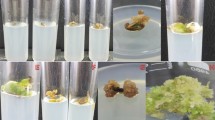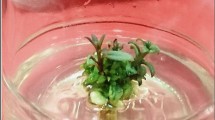Abstract
Psorelia corylifolia L. is a rich source of flavonoids, phenolics, antioxidants particularly psoralen with its significant biological activities. The plant products have great market demand on account of their versatile medicinal properties. Overexploitation from the wild and poor seed germination ability has enormously depleted its natural populations. Micropropagation is unconventional approach for its conservation and to fill market demand of its secondary metabolites. The present work was aimed to develop an efficient in vitro protocol for its rapid multiplication and large-scale production of secondary metabolites. Different phytohormonal combinations in Murashige and Skoog (MS) medium were used for shoot and callus induction. Maximum shoot induction (85.0%) through mature meristem culture was observed on MS medium supplemented with 1.5 mg/l BAP and 0.5 mg/l NAA. The callus induction and profuse shoot multiplication protocol was developed from leaf explants. MS medium with 1.5 mg/l BAP and 0.5 mg/l NAA was the best medium for maximum in vitro response of callus (85.0%), shooting and multiple shoots (7.0) with 8.5 cm length. A comparative analysis of psoralen content using HPLC, antioxidant properties, total flavonoid and phenolic contents was observed in field-grown seeds and in vitro raised callus. All these parameters were significantly higher in in vitro raised callus than field-grown seeds. The present investigation can serve as a prospective guide for in vitro regeneration, consequently for conservation and sustainable production of secondary metabolites from P. corylifolia.





Similar content being viewed by others
7. References
Rao GV, Annamalai T, Kavitha Mukhopadhyay T (2010) Chemical examination and biological studies on the seeds of P corylifoliaLinn. Research Journal of Chemical Sciences. 2(1):50–58
Mishra S., Bhiashajya Ratnavali Chaukhambha (2009). Publication Varanasi Edition (54) 302–310
The wealth of india, Raw materials CSIR., New Delhi (1995). viii,295–298.
Rajpal V. (2005). Eastern Publishers;. Standardization of Botanicals; Vol. 2. New Delhi pp. 284–95.
An H-J, Seo M-J, Choi I-Y, Park R-K, Jeong S, Lee J-Y, Kim H-M, Um J-Y, Hong S-H (2008) Induction of nitric oxide and tumour necrosis factor-α by Psoralea Corylifolia. Indian J Med Res 128:752–758
Zhao L.H., Wu M.H., Xiang BR. (2005). Analysis of P. corylifoliaL. fruits in different regions. Chem Pharm Bull (Tokyo).
Cheng Z.W., Cai X.F., Dat N.T., Hong S.S., Han A.R., Seo E.K., Hwang B.Y., Nan J.X., Lee D., Lee J.J. (2007). Bisbakuchiols A and B, novel dimeric meroterpenoids from Psoralea corylifolia.Tetrahedron Lett., 48, 8861–8864.Chinese J. Biotech., 24(5): 711–716.
Dev S, Nayak UR, Mehta G (1973) Monoterpenoids- I, P. corylifoliaLinn. - Bakuchiol, A novel monoterpene phenol. Tetrahedron 29:1119–1125
Prasad NR, Anand C, Balasubramanian S, Pugalendi KV (2004) Antidermatophytic activity of extracts from P. corylifolia(Fabaceae) correlated with the presence of a flavonoid compound. J Ethnopharmacol 91:21–24
Tang SY, Whiteman M, Peng ZF, Jenner A, Yong EL, Halliwell B (2004) Characterization of Antioxidant and Antiglycation properties and isolation of active ingredients from traditional chinese medicines. Free Radical Biol Med 36(12):1575–1587
Pae HO, Cho H, Oh GS, Kim NY, Song EK, Kim YC (2001) Bakuchiol from P. corylifoliainhibits the expression of inducible nitric oxide synthase gene via the inactivation of nuclear transcription factor kB in RAW 264.7 macrophages. International Journal of Immunopharmacology 1:1849–1855
Qamaruddin A, Parveen N, Khan NU, Singhal KC (2003) Potential antifilarial activity of the leaves and seeds extracts of P. corylifoliaon cattle filarial parasite Setariacervi. Journal of Ethnopharmacology 84(2–3):313
Zhang CZ, Wang SX, Zhang Y, Chen JP, Liang XM (2005) In vitro estrogenic activities of Chinese medicinal plants traditionally used for the management of menopausal symptoms. J Ethnopharmacol 98:295–300
Latha PG, Evans DA, Panikkar KR, Jayavardhanan KK (2000) Immunomodulatory and antitumor properties of P. corylifoliaseeds. Fitoterapia 71:223–231
Gidwani B, Alsapure RN, Duragkar NJ (2011) Pharmacognostic and standardization and physico-chemical evaluation of P. corylifoliaLinn seeds”. Imperial J Pharmacog Natural Prod 1:145–151
Baskaran N, Jayabalan, (2008) Effect of growth regulators on rapid micropropagation and psoralen production in P. corylifoliaL. Acta Physiologiae Plantarum 30(3):345–351
Jeyakumar M, Jayabalan N (2002) In vitro plant regeneration from cotyledonary node of P. corylifoliaL. Plant Tissue cult. 12(2):125–129
Wani TA, Pandith SA, Gupta AP, Chandra S, Sharma N, Lattoo SK (2017) Molecular and functional characterization of two isoforms of chalcone synthase and their expression analysis in relation to flavonoid constituents in Grewia asiatica L. PloS one 12:e0179155
Shah SN, Wani TA, Ram B, Koul M, Awasthi P, Rajput DS, Reddy GRS (2016) An efficient protocol for in vitro organogenesis and antioxidant studies in Melia dubia Cav.". Afr J Biotech 15(19):768–775
Pandey V., Agrawal V. (2009). Bioprospecting of Spilanthes species – Micropropagation and bioassay guided isolation of larvicidal compounds against malaria and filarial vectors [Ph.D. thesis]. Delhi: Department of Botany, University of Delhi.
Sehrawat N, Yadav M, Jaiwal PK (2013) Development of an efficient in vitro regeneration protocol for rapid multiplication and genetic improvement of an important endangered medicinal plant Psoralea corylifolia. Asian journal of plant science and research 3(4):88–94
Gupta NS, Banerjee M, Acharya K (2014) Influence of hormones and explants towards in vitro callusing and shoot organogenesis in a commercially important medicinal Plant. Int. J. Pharm. Sci. Rev. Res., 29:132–137
Nitnaware KM, Naik DG, Nikam TD (2011) Thidiazuron-induced shoot organogenesis and production of hepatoprotective lignan phyllanthin and hypophyllanthin in Phyllanthus amarus. Plant Cell Tiss Organ Cult 104:101–110
Teshome S, Feyissa T (2015) In vitro callus induction and shoot regeneration from leaf explants of Glinus lotoides (L.)-an important medicinal plant American. Journal of Plant Sciences 6:1329–1340
Jiang QB, Zhang Y, Zhong CL, Zeng B, Bogusz D, Franche C (2012) Establishment of an in vitro plant regeneration protocol for Casuarina cunninghamiana Miq. via indirect organogenesis. New Forests. 43(2):143–154
Dhar U, Joshi M (2005) Efficient plant regeneration protocol through callus for Saussurea obvallata (DC.) Edgew. (Asteraceae): effect of explant type, age and plant growth regulators. Plant Cell Rep 24:195–200
Mohd Anis and Mohd Faisal (2005) In vitro regeneration and mass multiplication of Psoralea corylifolia-an endangered medicinal plant. Indian Journal of Biotechnology 4:261–264
Khaleghi A, Khalighi A, Sahraroo A, Karimi M, Rasoulnia A, Ghafoori IN, Ataei R (2008) In vitro propagation of alstroemeria cv ‘Fuego.’ Am-Eur. J. Agric. Environ. Sci. 3(3):492–497
Mishra K, Ojha H, Chaudhury NK (2012) Estimation of antiradical properties of antioxidants using DPPH assay: a critical review and results. Food Chem 130:1036–1043
Amit T, Bhakuni RS (2010) New constiuents from Psoralea corylifolia. Ind J Chem 49B(2):256–259
Acknowledgements
NGN is thankful to the MPCST Bhopal for providing financial assistance and Director Indian institute of integrative medicine (IIIM) CSIR Canal Road Jammu for providing necessary research facilities. TAW is thankful to CSIR for providing Senior Research associateship under Scientist Pool scheme with pool No: 9092A.
Author information
Authors and Affiliations
Contributions
TAW conceived and designed the experiments; NGN performed bulk of the experiments as a part of her PhD programme; Support for chemical analyses was provided by ZAK; Data were analyzed by T.A.W.; ZAK. T.A.W. and NGN wrote the paper. All authors read, reviewed and approved the manuscript.
Corresponding author
Additional information
Publisher's Note
Springer Nature remains neutral with regard to jurisdictional claims in published maps and institutional affiliations.
Significance statement The present investigation is an efficient, rapid, improved method likely to be used for industrial supply of bulk and quality plant material. It can serve a prospective guide for its future sustainable exploitation.
Rights and permissions
About this article
Cite this article
Nabi, N.G., Wani, T.A. & Kaloo, Z.A. In Vitro Conservation Strategies for Sustainable Production of Secondary Metabolites in Psoralea corylifolia L.. Proc. Natl. Acad. Sci., India, Sect. B Biol. Sci. 91, 959–970 (2021). https://doi.org/10.1007/s40011-021-01298-z
Received:
Revised:
Accepted:
Published:
Issue Date:
DOI: https://doi.org/10.1007/s40011-021-01298-z




